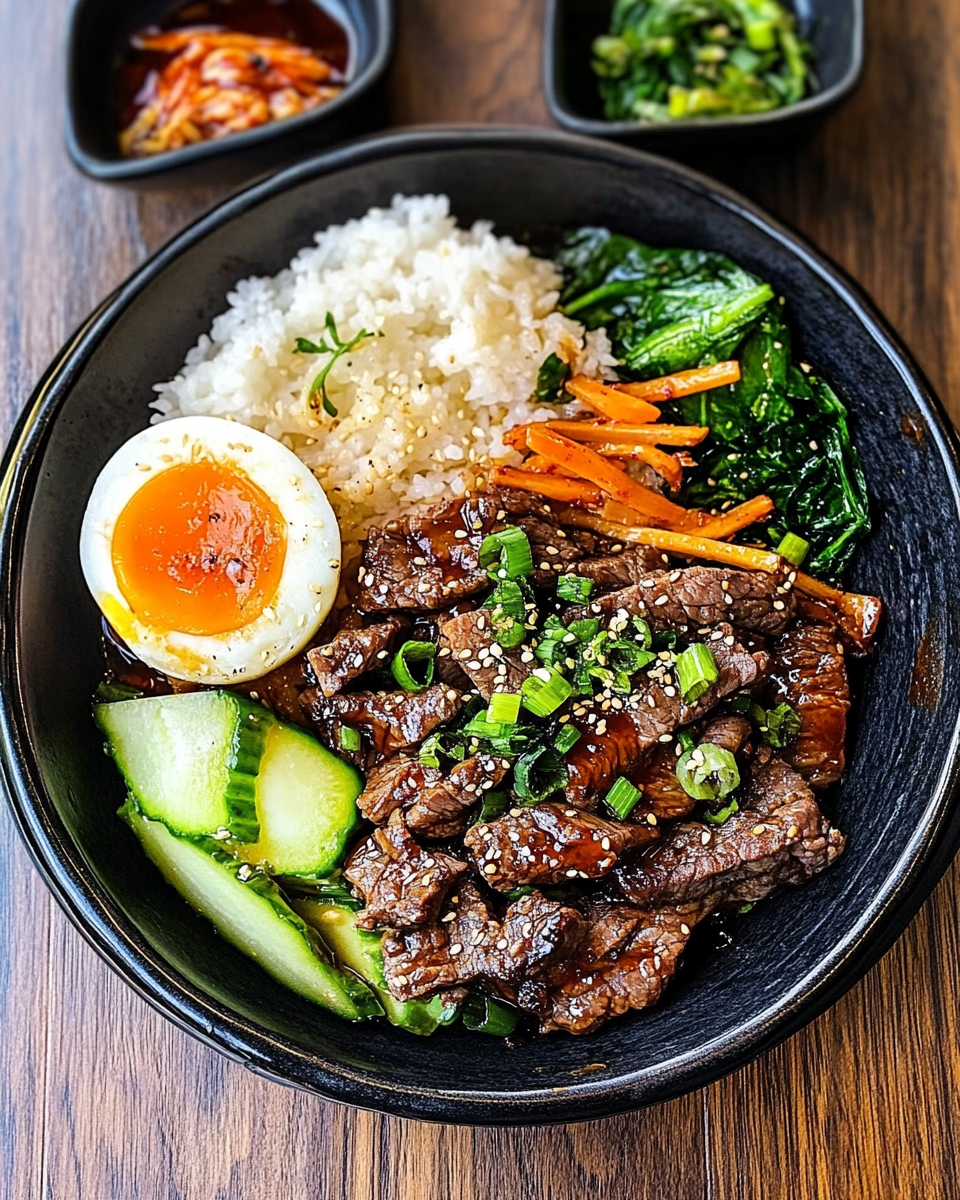Black Stone Korean BBQ Beef Bulgogi is a flavorful and tender marinated beef dish, grilled to perfection with a sweet and savory sauce. This classic Korean recipe highlights thinly sliced beef infused with garlic, soy, and sesame, ideal for a delicious and quick dinner.
FULL RECIPE
Ingredients
- 1 lb thinly sliced beef ribeye or sirloin
- 3 tbsp soy sauce
- 1 tbsp sugar
- 1 tbsp honey
- 2 tbsp sesame oil
- 3 cloves garlic, minced
- 1 small onion, thinly sliced
- 2 green onions, chopped
- 1 tsp grated ginger
- 1 tbsp rice wine or mirin
- 1 tbsp toasted sesame seeds
- 1/4 tsp black pepper
- Optional: sliced mushrooms or carrots
Directions
- In a bowl, combine soy sauce, sugar, honey, sesame oil, garlic, ginger, rice wine, and black pepper to create the marinade.
- Add the beef slices, onions, and green onions to the marinade and mix well. Cover and refrigerate for at least 30 minutes, preferably 2 hours.
- Preheat a grill or pan over medium-high heat.
- Cook the marinated beef and vegetables in batches, about 2-3 minutes per side until cooked through and slightly caramelized.
- Sprinkle with toasted sesame seeds before serving.
Nutritional Information
- Calories: 350 kcal per serving
- Protein: 30g
- Fat: 20g
- Carbohydrates: 10g
- Sodium: 800mg
- Sugar: 8g
History of Bulgogi
Bulgogi, meaning “fire meat” in Korean, has a rich history that dates back to the Goguryeo era (37 BC–668 AD). Traditionally, it was a royal dish enjoyed by Korean kings and nobles due to its tender and flavorful qualities. Over centuries, bulgogi evolved from simple grilled meat to a marinated delicacy, showcasing the Korean mastery of balancing sweet, salty, and savory flavors. Today, bulgogi is a beloved staple in Korean cuisine worldwide.
Cultural Significance
Bulgogi is more than just a dish; it symbolizes Korean hospitality and communal dining. It is often served during family gatherings, celebrations, and holidays. Sharing bulgogi around a grill fosters connection and conversation, embodying the spirit of togetherness that Korean meals emphasize.
Choosing the Right Cut of Beef
The key to authentic bulgogi lies in selecting tender cuts of beef. Ribeye, sirloin, and tenderloin are preferred because they have the perfect balance of marbling and softness. Thin slicing is essential to allow quick grilling and to maximize the marinade’s absorption.
Marinating Techniques
The marinade is fundamental in bulgogi’s flavor profile. Traditional recipes use soy sauce, sugar, garlic, sesame oil, and sometimes fruit purees like Asian pear or apple to tenderize the meat naturally. The marinade should be balanced to provide a subtle sweetness that complements the savory soy sauce base.
Flavor Profile
Bulgogi strikes a perfect balance between sweet, salty, and umami. The garlic and ginger add warmth and depth, while sesame oil contributes a nutty aroma. The slight caramelization during grilling enhances the meat’s natural sugars, creating a deliciously complex taste.
Importance of Thin Slicing
Thin slices not only cook quickly but also absorb marinade more effectively. This results in evenly flavored meat that is tender and juicy. Thicker cuts can be tough and less flavorful, so achieving uniform thinness is a crucial step in bulgogi preparation.
Vegetables in Bulgogi
Adding vegetables like onions, carrots, and mushrooms enhances both flavor and texture. Onions add sweetness, carrots offer a subtle crunch, and mushrooms contribute an earthy note. These vegetables also absorb the marinade, making each bite varied and satisfying.
Cooking Methods
Bulgogi can be cooked on a traditional Korean barbecue grill, a stovetop pan, or even a broiler. Each method offers a slightly different texture: grilling imparts smokiness, pan-frying provides a caramelized crust, and broiling cooks the meat quickly while locking in juices.
Serving Suggestions
Bulgogi is often served with steamed rice and an array of banchan, or Korean side dishes like kimchi, pickled radishes, and seasoned spinach. Lettuce leaves or perilla leaves are commonly used to wrap the meat, along with garlic slices and ssamjang (a spicy dipping sauce), enhancing the overall eating experience.
Health Considerations
While bulgogi is rich in protein and offers essential nutrients, it can be high in sodium and sugar due to the marinade. Moderation and balance with fresh vegetables and whole grains are recommended for a nutritious meal.
Variations of Bulgogi
Regional and modern variations exist, including pork bulgogi (dwaeji bulgogi), chicken bulgogi, and even vegetarian versions using tofu or mushrooms. Each variation brings unique flavors but maintains the core marinating and grilling techniques.
Bulgogi in Popular Culture
Bulgogi has transcended Korean cuisine to become popular globally, often featured in Korean dramas, films, and food festivals. It symbolizes Korean culture and culinary excellence, contributing to the worldwide popularity of Korean food.
Marinade Storage Tips
Preparing marinade in advance can deepen the flavor. It is advisable to marinate the beef for at least 30 minutes, but longer marination (up to 24 hours) in the refrigerator enhances tenderness and taste. Leftover marinade should be discarded to avoid contamination.
Pairing Bulgogi with Beverages
Bulgogi pairs wonderfully with traditional Korean alcoholic beverages like soju and makgeolli. For non-alcoholic options, lightly sweetened barley tea or green tea complements the rich flavors without overpowering the palate.
Texture and Mouthfeel
The combination of tender beef and crunchy vegetables offers a pleasing contrast. Proper grilling creates a slight char and caramelization that adds complexity to the meat’s texture, making every bite enjoyable.
Using Fruit in Marinades
Fruits such as Asian pear or apple are commonly used in bulgogi marinades for their natural enzymes that break down meat fibers, resulting in a softer texture. They also add a subtle sweetness that enhances the marinade without overpowering the dish.
Gluten-Free Adaptations
To accommodate gluten-free diets, soy sauce can be replaced with tamari or coconut aminos. These alternatives preserve the essential savory flavor while ensuring the dish is suitable for those with gluten sensitivities.
Cooking Equipment Recommendations
A cast-iron skillet or a grill pan works best for indoor cooking to achieve high heat and proper searing. Outdoor grills provide authentic smoky flavor, but a well-heated pan can create a similar result.
Leftover Storage and Reheating
Bulgogi can be refrigerated for up to 3 days and reheated gently in a pan to preserve moisture. It also freezes well, making it convenient for meal prepping and future quick meals.
Advertisement
Bulgogi as a Meal Prep Option
Due to its ease of cooking and storage, bulgogi is ideal for meal prepping. Preparing a large batch allows for quick assembly of lunches or dinners, paired with fresh vegetables and rice.
Conclusion
Black Stone Korean BBQ Beef Bulgogi exemplifies the beauty of Korean cuisine—simple ingredients transformed by meticulous preparation and balanced flavors. Its history and cultural importance make it more than just a dish; it is a culinary experience meant to be shared and savored. Whether enjoyed at a traditional Korean BBQ or cooked at home, bulgogi’s sweet, savory, and tender qualities continue to captivate food lovers worldwide, making it a timeless classic that bridges culture, tradition, and modern tastes.






